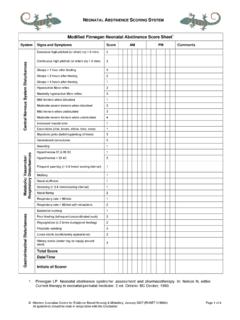Transcription of Neonatal Abstinence Scoring Tool (NAS) Date Weight Please ...
1 Neonatal Abstinence Scoring Tool (NAS) Date Weight Please use one sheet per day. Thank You. Time Signs & Symptoms Score AM PM Comments CNS Disorders Crying: Excessive High Pitched Crying: Cont. High Pitched 2 3 Sleeps < 1 hr after feeding Sleeps <2 hr after feeding Sleeps < 3 hr after feeding 3 2 1 Hyperactive Moro Reflex Markedly Hyperactive Moro Reflex 2 3 Mild Tremors: Disturbed Mod-Severe Tremors: Disturbed 1 2 Mild Tremors: Undisturbed Mod-Severe Tremors Undisturbed 3 4 Increased Muscle Tone 2 Excoriation (specific area) 1 Myoclonic Jerk 3 Generalized convulsions 5 Metabolic, Vasomotor, and Respiratory Disturbance Sweating 1 Fever < 101 ( ) Fever > 101 ( ) 1 2 Frequent Yawning (> 3) 1 Mottling 1 Nasal Stuffiness 1 Sneezing (>3) 1 Nasal Flaring 2 Respiratory rate (> 60/min)
2 Respiratory rate (>60/min with retractions 1 2 Gastro-Intestinal Disorders Excessive Sucking 1 Poor Feeding 2 Regurgitation Projectile Vomiting 2 3 Loose Stools Watery Stools 2 3 Total Score Initials of Scorer 1 Initials of Scorer 2 Inter-observer reliability % Average daily score Adopted from Finnegan, (1986). Neonatal Abstinence syndrome: Assessment and pharmacologic management.)
3 In Rubatelli & Granadi (Eds.), Neonatal Therapy: An update. New York: Exerpta Medica NAS Definitions (Finnegan Tool) (D Apolito, K, 1994; 2010) Disturbed Sleep: Score longest sleep interval (<1, <2 or <3 hours) after a feeding. Excessive High-Pitched Crying: Score if crying continues for > 15 seconds despite self- consoling measures. Also score if intermittent or continuous crying is present for up to 5 minutes. Also score if these signs are present without high-pitched crying. Continuous High-Pitched Crying: Score if the infant is unable to use self-consoling measures to decrease crying within a 15 sec period. Also score if there is continued crying for > 5 min despite caregiver interventions. Also score if these signs are present without high-pitched crying. Excessive Sucking: Increased rooting (more than 3 times) with rapid swiping movements of hand across mouth in attempt to suck on fist, hands or pacifier before or after a feeding.
4 Fever: > or equal to Hyperactive Moro: Pronounced jitteriness of the hands during or at the end of a Moro reflex. Be sure the infant is quiet when performing this reflex. Also score if there is an increased number of non-elicited Moro reflexes. Markedly Hyperactive Moro: Pronounced jitteriness and clonus of the hands and/or arms during or after initiation of reflex. Clonus is present when you have more than 8-10 jerks or beats of the hands or feet (use dorsiflexion of the foot or hand to determine clonus). Mild Tremors Disturbed: Tremors of the hands or feet when asleep, awake, active or alert while being handled (disturbed). Moderate-Severe Tremors Disturbed: Tremors of the arms (one or both) or legs with or with or without tremors of the hands or feet when asleep, awake, active or alert while being handled (disturbed). Mild Tremors Undisturbed: Observable tremors the hands or feet while infant is asleep, awake, active or alert and not being handled by a caregiver.
5 Moderate-Severe Tremors Undisturbed: Tremors of the arms or legs, with or without tremors of the hands an/or feet while asleep, awake, active or alert while not being handled by a caregiver. Increased tone: No head lag when pulled to the sitting position with total body rigidity. Excoriation: Rubbing of extremities against bed linen. Does not include diaper rash. Myoclonic Jerks: Multiple jerks (not tremors) of the arms, leg or facial muscles. Generalized Convulsions: Tonic seizures or subtle signs of eye staring, chewing, rowing motions, arching, fist clenching, bicycling. Sweating: Score if feel wetness on forehead, upper lip or back of neck. Fever or > Frequent Yawning: Yawns > three times in testing period. Mottling: Marbled appearance of pink and pale or white areas on trunk, arms or legs. Nasal Stuffiness: Nasal drainage with or without a stuffy nose. Sneezing: Sneezes > 3 times within a timing interval.
6 Nasal Flaring: Outward spreading of nostrils during breathing. Respiratory Rate: > 60/minute with or without retractions. Excessive Sucking: Increased rooting (> 3 times) with swiping movements of hand across mouth. Poor Feeding: Excessive sucking prior to feeding but inadequate suck when fed. Regurgitation: Frequent regurgitation (> 2 times) not associated with burping. Projectile Vomiting: Forceful ejection of stomach contents from the mouth. Loose Stool: A curdy, mushy or seedy stool that does not have a water ring around the stool on the diaper. Watery stool: Any type of stool with a water ring around the stool on the diaper. Inter-Rater Reliability Check For NAST Total Number of Item Agreements Total Number of Item Disagreements Percent Score 10 0 100% 9 1 90% 8 2 80% Acceptable inter-rater reliability is 90% or greater, however, attempting to obtain 100% reliability is optimal (D Apolito, K.)
7 , 2010).



